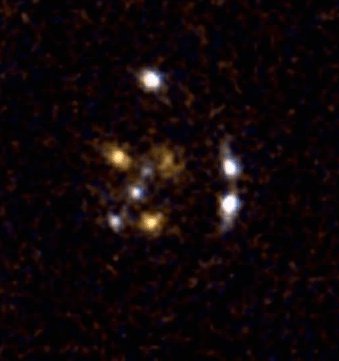The first simple 'gravitational lens' to create six separate images of a distant galaxy has been discovered. Unlike other more complex systems, the lens is made up of just three galaxies, which focus the light from the background galaxy. David Rusin of the University of Pennsylvania and colleagues are confident that their simulations of gravitational lensing based on the lens - known as B1359+154 - can be expanded to explain the behaviour of more sophisticated systems (D Rusin et al 2001 Astrophysical Journal 557 594).

The galaxies that make up lens B1359+154 are around seven billion light-years away and lie in the line of sight of the more distant galaxy, which is over 11 billion light-years away. Rusin and co-workers observed radio emissions and visible light in the constellation of Bootes using the ten ground-based radio-telescopes that make up the Very Long Baseline Array and the Hubble Space Telescope.
Rusin and colleagues used the position and brightness data of the intervening galaxies to simulate how the light of the distant galaxy would be bent. Their prediction closely matched the pattern of images observed. “We think this work will give us an excellent tool for studying much denser clusters of galaxies and the relationships of the individual galaxies to the ‘halo’ of dark matter in which they are embedded”, says team member Martin Norbury.
More complex clusters of galaxies have been known to form lenses that create up to eight images of a background object. Such large numbers of galaxies make it difficult to determine how the gravity of each one affects the behaviour of the lens, but this is much easier with just three galaxies. “Systems such as B1359+154 are very rare”, says Rusin, “so this discovery is an important stepping stone”.



